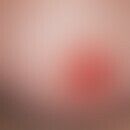Synonym(s)
HistoryThis section has been translated automatically.
DefinitionThis section has been translated automatically.
Extramammary Paget's disease is a rare form of Paget's disease in regions of the body with apocrine sweat glands, e.g. anogenital region, armpits, umbilical region.
You might also be interested in
ManifestationThis section has been translated automatically.
Women are affected 3-4 times more often than men (Caucasian populations).
In Japan, extramammary Paget's disease is seen preferentially in men.
The mean age in major studies was 70 years (61-78 years).
The median time from onset of initial symptoms to diagnosis was 24 months.
LocalizationThis section has been translated automatically.
Anogenital area (most frequent localization); less frequently: perineum, genitals (penis, scrotum, mons pubis), axillae, inguinal regions.
ClinicThis section has been translated automatically.
Typical is a (solitary) sharply defined, 1.0-10.0 cm large plaque with tongue-shaped extensions, possibly with accentuated edges, flat, often erosive or weeping, clearly infiltrated due to the intertriginous localization (axillae, groin region, genitoanal region). In some cases, hyper- or hypopigmentation has also been described (Zhao C 2025), resulting in brownish coloration of the plaques.
Itching (or mild pain) is a leading symptom of the lesions (Patrizi A 2017).
Equally typical is a diagnostic misinterpretation of the initial lesions as anal eczema, perianal psoriasis or inguinal or axillary tinea.
HistologyThis section has been translated automatically.
In a mostly hyperplastic and parakeratotic epidermis, in older lesions also growing downwards at the skin appendages, there are mostly single and randomly scattered, large, bright cells with large pleomorphic nuclei (Paget cells). This "Swiss cheese pattern" is diagnostically very characteristic (see also pagetoid). In sections, the cells in the epithelium can also condense into nests. The Paget cells are CEA-positive and also stain with low-molecular cytokeratins. Important: the cells are Melan A and S100 negative.
DiagnosisThis section has been translated automatically.
Differential diagnosisThis section has been translated automatically.
Tinea corporis (culture, histologic clarification if necessary)
Tinea inguinalis (culture, histological clarification if necessary)
Lichen sclerosus (histological clarification)
Intertrigo (clear inflammatory component, obesity)
M. Bowen's disease (histological clarification)
Complication(s)(associated diseasesThis section has been translated automatically.
Adnexal adenocarcinoma in 25% of cases. Transmission of the tumor cells per continuitatem! In 15% carcinoma of internal organs (rectum, bladder, prostate, cervix or urethra). A metastatic process must be assumed here.
Remark: The high association between extramammary Paget's disease (EMPD) and associated carcinomas is not confirmed in other studies. However, patients with EMPD appear to have a higher risk of developing a second primary malignancy. Multiple EMPDs have also been reported (Zhao C et al. 2024)
TherapyThis section has been translated automatically.
Excision far into the healthy area with a safety margin of 1-2 cm, since Paget's cells are also observed outside the clinically healthy zone. In case of extensive tumours or tumours in difficult localisation, leave the defect open. Edge cut and deep (step) cut control (microscopically controlled surgery)! Cover the defect with split or full skin.
External therapyThis section has been translated automatically.
Alternative to the surgical procedure (these measures are only recommended to very experienced therapists):
- Local applications of 5-fluorouracil (Efudix®)
- Local applications of Imiquimod (Aldara®)
Radiation therapyThis section has been translated automatically.
Radiotherapy may be recommended as an alternative to surgery.
AftercareThis section has been translated automatically.
Close-meshed follow-up checks are absolutely necessary for all procedures, especially the non-operative ones.
LiteratureThis section has been translated automatically.
- Chiba H et al. (2000) Two cases of vulval pigmented extramammary Paget's disease: histochemical and immunohistochemical studies. Br J Dermatol 142: 1190-1194
- Crocker HR (1888-1889) Paget's disease affecting the scrotum and penis. Trans Pathol Soc Lond 40: 187-191
- Ito T et al. (2015) Tumor thickness as a prognostic factor in extramammary Paget's
disease. J Dermatol 42:269-275 - Ladak A et al. (2014) Unilateral Pigmented Extramammary Paget's Disease
of the Axilla Associated with a Benign Mole: A Case Study and a Review of
Literature. Korean J Pathol 48:292-296 - Luk NM et al. (2003) Extramammary Paget's disease: outcome of radiotherapy with curative intent. Clin Exp Dermatol 28: 360-363
- Molinie V et al (1993) Paget's disease of the vulva. 36 cases. Ann Dermatol Venerol 120: 522-527
- Moreno-Arias GA et al. (2003) Radiotherapy for in situ extramammary Paget disease of the vulva. J Dermatolog Treat 14: 119-123
- O'Connor WJ et al. (2003) Comparison of mohs micrographic surgery and wide excision for extramammary Paget's disease. Dermatol Surg 29: 723-727
- Patrizi A (2017) Extramammary Paget's disease. J Dtsch Dermatol Ges. 15: 856-859
- Rajendran S et al. (2014) Extramammary Paget's disease of the perianal
region: a 20-year experience. ANZ J Surg 12. doi: 10.1111/ans.12814 - Yamamoto O et al. (2003) Extramammary Paget's disease with superimposed herpes simplex virus infection: immunohistochemical comparison with cases of the two respective diseases. Br J Dermatol 148: 1258-1262
- Zhao C et al. (2024) Protruding mass in the pubis. J Dtsch Dermatol Ges 22:597-600.
- Zhao C (2025). Asymptomatic reddish patch with hypopigmentation in the axilla. J Dtsch Dermatol Ges 23:118-122.
Incoming links (12)
Adenocarcinoma apocrinocellulare epidermotropicum; Adenocarcinomas, apocrine; Ain; Anal dermatitis cumulative toxic; Anal eczema contact allergic; Paget's carcinoma; Paget's disease; Paget's disease of the nipple; Perianal streptococcal dermatitis; Rankl; ... Show allOutgoing links (11)
Bowen's disease; Cea; Cytokeratins; Excision; Intertrigo; Mart1; Pagetoid; Paget's disease of the nipple; Pruritus; Punch biopsy; ... Show allDisclaimer
Please ask your physician for a reliable diagnosis. This website is only meant as a reference.













